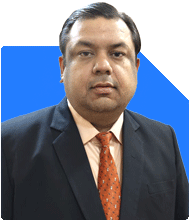Ramalingam Kalirajan |9255 Answers |Ask -Follow
Mutual Funds, Financial Planning Expert - Answered on May 26, 2024
He has an MBA in finance from the University of Madras and is a certified financial planner.
He is the director and chief financial planner at Holistic Investment, a Chennai-based firm that offers financial planning and wealth management advice.... more

I am 47 yrs old , had been investing in SIP since last 13 yrs . I started with 5 k , increase the sip every alternate year by 5k , so currently doing around 50k per month. My XIRR is around 19 % presently since 2010. I have portfolio value of 1.3 Cr. I have 2 daughters age 15 and 5 , need 3-4 cr for higher education and marriage for both. Need 5 Cr for my retirement at 60 . Will I achieve my goal or I need a higher increase in sip amount. Though I have planned retirement at 60 , I am a super specialist doctor , can comfortably make 3-4 L in a month even after I retire from Govt service.
Current Financial Situation
1. Investment History
You have been investing in SIPs for 13 years, starting with Rs. 5,000 and increasing your SIP amount by Rs. 5,000 every alternate year. Currently, you are investing Rs. 50,000 per month.
2. Portfolio Value
Your portfolio value has grown to Rs. 1.3 crores with an XIRR of around 19% since 2010. This is a strong return on investment.
Financial Goals
1. Higher Education and Marriage for Daughters
You need Rs. 3-4 crores for the higher education and marriage of your two daughters, aged 15 and 5.
2. Retirement Corpus
You aim to accumulate Rs. 5 crores for your retirement by age 60. Although you plan to continue earning Rs. 3-4 lakhs per month post-retirement, having a substantial retirement corpus will provide financial security.
Projecting Future Growth
1. Assumptions
Current SIP Amount: Rs. 50,000 per month
Annual Increase in SIP: Assuming you continue to increase by Rs. 5,000 every alternate year
Expected Return: Continuing with a conservative estimate of 12% annual return on mutual funds (though your XIRR is higher)
Investment Horizon: 13 more years until retirement at age 60
2. Projected Corpus Calculation
Using these assumptions, let’s project the potential growth of your investments. Over the next 13 years, with continued SIP increases and a reasonable rate of return, your corpus can grow significantly.
Meeting Financial Goals
1. Higher Education and Marriage Costs
You need Rs. 3-4 crores for your daughters' higher education and marriage. By allocating part of your current and future investments specifically for these goals, you can ensure you meet these needs.
2. Retirement Corpus
Aiming for Rs. 5 crores for retirement, considering your current portfolio and future contributions, seems achievable. However, ensuring you increase your SIP amounts periodically and maintain a diversified portfolio is crucial.
Recommendations for Optimization
1. Increase SIP Contributions
Given your current financial capacity and goals, consider increasing your SIP amount more frequently or by a higher amount. Instead of Rs. 5,000 every alternate year, increasing annually or by a larger amount could help.
2. Review and Rebalance Portfolio
Regularly review and rebalance your portfolio to ensure it remains aligned with your financial goals. Replace underperforming funds with better-performing ones.
3. Focus on Quality Funds
Ensure that your investments are in high-quality mutual funds with a consistent track record. Avoid overlapping and concentrate on diversified and well-managed funds.
4. Emergency Fund and Insurance
Ensure you have an adequate emergency fund and sufficient insurance coverage. This provides financial security and protects your investments from unexpected events.
Consulting a Certified Financial Planner
1. Personalized Advice
A Certified Financial Planner (CFP) can provide personalized advice based on your unique financial situation, goals, and risk tolerance. This tailored approach can optimize your investment strategy.
2. Expert Management
A CFP continuously monitors your investments and makes necessary adjustments based on market conditions. This ensures your portfolio stays on track to meet your financial goals.
3. Risk Management
A CFP employs strategies to manage risk and optimize returns, helping you navigate market volatility and safeguard your investments.
Final Thoughts
You are on a strong path with your disciplined investment approach and impressive returns. To ensure you achieve your goals of Rs. 3-4 crores for your daughters' higher education and marriage, and Rs. 5 crores for your retirement, consider increasing your SIP contributions more aggressively and regularly reviewing your portfolio.
Consulting with a Certified Financial Planner can provide you with personalized advice and expert management to keep your investments on track. Your continued commitment to disciplined investing and strategic planning will help you achieve your financial aspirations.
Best Regards,
K. Ramalingam, MBA, CFP
Chief Financial Planner,
www.holisticinvestment.in
You may like to see similar questions and answers below
Nikunj Saraf | Answer |Ask -Follow
Mutual Funds Expert - Answered on Nov 11, 2022
Ramalingam Kalirajan |9255 Answers |Ask -Follow
Mutual Funds, Financial Planning Expert - Answered on Apr 17, 2024
Ramalingam Kalirajan |9255 Answers |Ask -Follow
Mutual Funds, Financial Planning Expert - Answered on Jul 13, 2024
Ramalingam Kalirajan |9255 Answers |Ask -Follow
Mutual Funds, Financial Planning Expert - Answered on Jul 16, 2024
Ramalingam Kalirajan |9255 Answers |Ask -Follow
Mutual Funds, Financial Planning Expert - Answered on Sep 02, 2024
Radheshyam Zanwar |4292 Answers |Ask -Follow
MHT-CET, IIT-JEE, NEET-UG Expert - Answered on Jun 28, 2025
Yogendra Arora |36 Answers |Ask -Follow
Tax Expert - Answered on Jun 28, 2025
Yogendra Arora |36 Answers |Ask -Follow
Tax Expert - Answered on Jun 28, 2025
Radheshyam Zanwar |4292 Answers |Ask -Follow
MHT-CET, IIT-JEE, NEET-UG Expert - Answered on Jun 28, 2025
Radheshyam Zanwar |4292 Answers |Ask -Follow
MHT-CET, IIT-JEE, NEET-UG Expert - Answered on Jun 28, 2025
Dr Nagarajan J S K |1432 Answers |Ask -Follow
NEET, Medical, Pharmacy Careers - Answered on Jun 28, 2025
Dr Nagarajan J S K |1432 Answers |Ask -Follow
NEET, Medical, Pharmacy Careers - Answered on Jun 28, 2025
Dr Nagarajan J S K |1432 Answers |Ask -Follow
NEET, Medical, Pharmacy Careers - Answered on Jun 28, 2025
Dr Nagarajan J S K |1432 Answers |Ask -Follow
NEET, Medical, Pharmacy Careers - Answered on Jun 28, 2025
Dr Nagarajan J S K |1432 Answers |Ask -Follow
NEET, Medical, Pharmacy Careers - Answered on Jun 28, 2025























